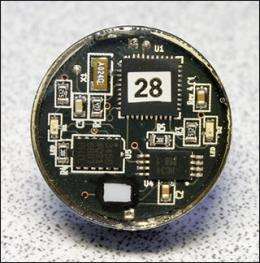LRC’s 'Dimesimeter' named Top 10 Innovation

The Scientist magazine unveiled the Top 10 Innovations of 2011, and coming in at number eight was the Dimesimeter, a circadian light and activity sensor developed by the Lighting Research Center (LRC) at Rensselaer through funding from the National Institute on Aging.
The Scientist invited members of the life science community to submit descriptions of exciting tools that made an impact in research, according to the magazine’s official announcement. More than 65 entries were reviewed by a panel of experts who were asked to evaluate the technologies and come up with the top 10 innovations of 2011.
The Dimesimeter is calibrated in terms of the spectral sensitivities of the visual and the circadian systems, as the circadian system is much more sensitive to short-wavelength (“blue”) light. Commercially available light measurement devices are only calibrated to measure light for vision.
“Biology is driven by circadian rhythms at every level, and light is the main stimulus for synchronizing the circadian system to the solar day. By quantifying an individual’s light/dark exposure pattern, we can prescribe ‘light treatments’ promoting circadian entrainment, thereby improving health and well-being,” explains Mariana Figueiro, director of the Light and Health Program at LRC, and principal investigator on the project.
Growing evidence indicates that circadian disruption by irregular light/dark patterns is associated with reduced quality of life and increased risk of disease. The Dimesimeter system—a combination of light monitoring and therapy prediction—has the potential to positively affect the lives of millions who suffer from circadian rhythm sleep disorders, including persons with Alzheimer’s disease.
Persons with Alzheimer’s disease and related dementias (ADRD) suffer from erratic sleep cycles, nocturnal wandering, and daytime irritability, which can make it difficult for family caregivers to maintain a safe, at-home environment. These sleep disturbances are due, in part, to the absence of daily, robust light/dark pattern exposures, says Figueiro.
Provided by Rensselaer Polytechnic Institute


















